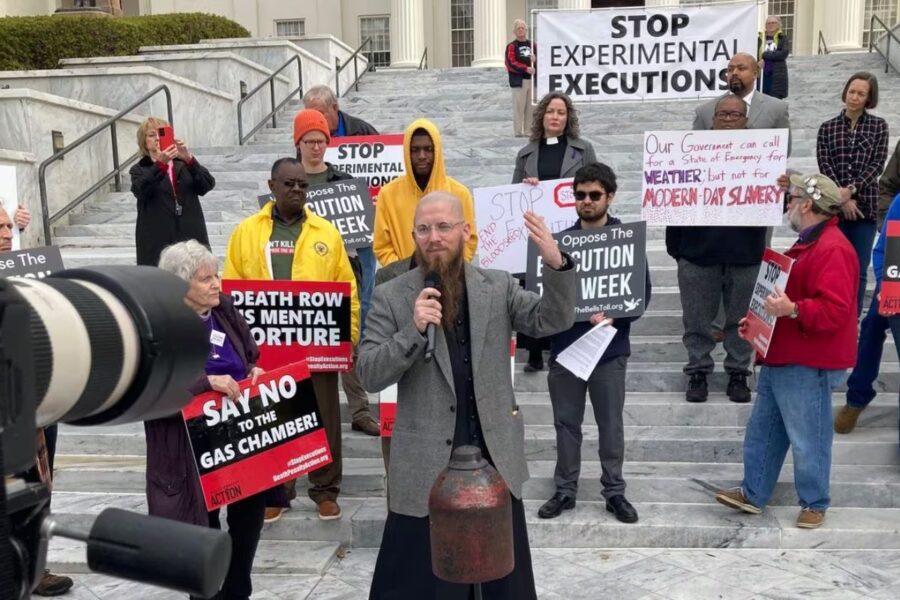A Never Before Used Method: In a significant departure from traditional execution methods, Alabama is poised to become the first state to use nitrogen gas as a means of capital punishment. This unprecedented move has sparked heated debates among legal experts, activists, and medical professionals.
At the center of the controversy is the case of death row inmate, Thomas Arthur Smith, who has been fighting against this new execution method. As the execution protocol details of the nitrogen gas method are unveiled, comparisons are being drawn with the commonly used lethal injection.
Legal and public perspectives on this issue vary widely, with some expressing confidence in the new method’s efficacy, while others raise concerns and criticism. Additionally, ethical and medical considerations surrounding the use of nitrogen gas in executions are being fiercely debated.
The implications of this groundbreaking approach to capital punishment are far-reaching, calling into question the morality and constitutionality of lethal injections and opening up a dialogue on the future of execution methods.
Key Takeaways
- Alabama’s decision to use nitrogen gas as a method of execution is unprecedented and controversial, replacing the previously failed lethal injection method.
- There is ongoing legal opposition and a battle over the constitutionality of Alabama’s use of nitrogen gas, with the expectation of an appeal to the U.S. Supreme Court.
- The execution protocol for nitrogen gas involves strapping the inmate to a gurney and administering the gas through a respirator, with a minimum duration of 15 minutes or until flatline on an EKG.
- The use of nitrogen gas as an execution method has generated varying opinions, with some supporting its legality and others raising concerns about the potential pain, ethical considerations, and uncertainties regarding its effects.
Unprecedented Execution Method: Alabama’s Use of Nitrogen Gas
Alabama’s use of nitrogen gas as an execution method is unprecedented and has sparked controversy due to concerns of cruelty and experimentation.
Instead of using lethal injection, the state has chosen to employ an industrial-type respirator mask that replaces breathing air with pure nitrogen gas.
This approach marks a departure from a previous failed attempt at lethal injection in 2022, which was called off due to a faulty IV connection.
Critics argue that the use of nitrogen gas is untested and could potentially subject the inmate to a prolonged and painful death. Furthermore, the novelty of this method raises questions about its effectiveness and the potential for unintended consequences.
The unprecedented use of nitrogen gas as an execution method in Alabama has ignited a heated debate over the ethics and humanity of capital punishment.

READ MORE: Former Governor Wants to Stop Execution Kenneth Eugene Smith
Legal Battle and Opposition: Smith’s Fight Against the New Execution Method
Smith’s legal team is challenging Alabama’s use of nitrogen gas as an execution method, arguing that further legal scrutiny is necessary before its application. They contend that Alabama is using Smith as a guinea pig for this untested method, demanding a more comprehensive examination of its constitutionality.
Despite these objections, both the U.S. Supreme Court and the 11th Circuit Court of Appeals have rejected Smith’s claims, asserting that the use of nitrogen gas does not violate the constitutional prohibition against cruel and unusual punishment.
Smith’s attorneys are expected to appeal this decision to the U.S. Supreme Court, hoping to garner further review and potentially halt the implementation of the nitrogen gas execution method. The legal battle surrounding this issue is ongoing, with both sides firmly entrenched in their positions.
Execution Protocol Details: Nitrogen Gas Method vs. Lethal Injection
The execution protocol for the use of nitrogen gas as a method of execution involves securing the inmate to a gurney and administering the gas through a ‘full facepiece supplied air respirator’ for a minimum of 15 minutes or until a flatline indication on the EKG is observed.
Contrasting with the widely used lethal injection method that has faced challenges due to the scarcity of relevant drugs.
- Nitrogen Gas Method:
- Inmate is strapped to a gurney.
- Nitrogen gas is administered through a full facepiece supplied air respirator.
- Minimum duration of 15 minutes or until a flatline indication on the EKG is observed.
- Lethal Injection Method:
- Inmate is injected with a sequence of drugs.
- Challenges due to the scarcity of relevant drugs have been faced.
The use of nitrogen gas as a method of execution provides an alternative to lethal injection and addresses the challenges posed by the scarcity of drugs. The protocol ensures that the inmate is securely restrained and that the gas is administered for a sufficient duration to ensure a humane execution.
Legal and Public Perspectives: Confidence, Criticism, and Victim’s Advocacy
Public opinion and legal perspectives vary on the use of nitrogen gas as a method of execution. Some express confidence in its legality, while others raise concerns and advocate for justice.
Alabama Attorney General Steve Marshall asserts that the execution is legally sound, citing the state’s authority to choose the method. However, critics, including Charles Sennett Jr., the son of the victim, argue that the punishment must fit the crime. Sennett insists that Thomas Arthur Smith, the inmate to be executed, must ‘pay for what he’s done.’ Smith was convicted of a murder-for-hire slaying in 1988.
Medical experts and organizations have also raised concerns about the use of nitrogen gas. They question its efficacy and potential for causing pain and suffering.
These differing perspectives highlight the complex and contentious nature of capital punishment in the United States.

Ethical and Medical Concerns: Debates Surrounding Nitrogen Gas Execution
Debates surrounding the ethical and medical concerns of executing inmates with nitrogen gas have sparked controversy and raised questions about potential complications and risks.
The use of nitrogen gas as a method of execution is met with skepticism from medical experts and human rights organizations. Here are some key points to consider:
- Medical concerns:
- Dr. Philip Nitschke, an euthanasia expert, has expressed concerns about potential complications due to facial hair and involuntary movements during the execution process.
- The lack of precedent in executing an inmate with nitrogen gas raises concerns about the potential distressing nature of the anoxic environment.
- Ethical concerns:
- The use of nitrogen gas for execution has drawn criticism from the American Veterinary Medical Association and UN Human Rights Council experts, who caution against its use.
- The debate over the ethics, constitutionality, and potential risks associated with the nitrogen gas method continues, leaving the fate of inmates involved in such executions uncertain.
As Alabama prepares for this unprecedented execution, the ethical and medical concerns surrounding nitrogen gas execution remain unresolved.
Conclusion Of A Never Before Used Method
Alabama’s decision to use nitrogen gas as a method of execution has sparked legal battles, opposition, and debates surrounding its ethical and medical implications.
While some view this method as a more humane alternative to lethal injection, others express concerns about its effectiveness and the potential for prolonged suffering.
The use of nitrogen gas for executions remains a topic of controversy, with legal and public perspectives varying greatly on its use.
Our Reader’s Queries
What is the new execution method nitrogen hypoxia?
Carrying out an execution using nitrogen hypoxia entails compelling an individual to inhale only nitrogen, cutting off their oxygen supply for bodily functions, ultimately causing death. The U.S. Chemical Safety Board emphasizes that breathing pure nitrogen is safe only when it’s mixed with oxygen.
Who was the man executed with nitrogen?
In Atmore, Alabama, Kenneth Eugene Smith, found guilty in a 1988 murder-for-hire scheme, might make history as the initial death row inmate executed through nitrogen hypoxia in the U.S.
What gas is used for execution?
Back in 1924, Nevada introduced the use of cyanide gas in its quest for a more humane method of executing condemned prisoners. The first individual to face lethal gas was Gee Jon, with the state attempting to pump cyanide gas into Jon’s cell while he was asleep.
What chemical is used to execute?
The administered drugs include pancuronium bromide, a paralyzing agent; potassium chloride, which halts cardiac activity; and sodium thiopental, serving as an anesthetic.
Is death by nitrogen hypoxia painless?
Having experienced altitude hypoxia simulation during his training as a former Air Force and Delta Airlines pilot, Lippincott is confident that death by nitrogen hypoxia would be painless. He described the sensation as akin to feeling sleepy with a warm sensation.

